
|
Now it is 8.6 mag (Sept. 9, Michael Mattiazzo). It stays bright as 8-9 mag until early November. It will be observable in excellent condition in the Southern Hemisphere. It locates very low in the Northern Hemisphere.
Date(TT) R.A. (2000) Decl. Delta r Elong. m1 Best Time(A, h)
Sept.19 16 2.70 -24 4.0 1.380 1.356 67 8.9 19:25 ( 45, 15)
Sept.26 16 27.92 -25 17.2 1.399 1.353 66 8.8 19:15 ( 43, 15)
|

|
It approached to Sun down to 0.29 a.u. on July 3, and it brightened up to 0.6 mag (Alan Hale). Now it is fading. It has already faded down to 9.8 mag (Sept. 13, Katsumi Yoshimoto). It stays observable in the evening sky until early October when it fades down to 11 mag.
Date(TT) R.A. (2000) Decl. Delta r Elong. m1 Best Time(A, h)
Sept.19 14 50.38 -9 23.7 2.269 1.748 47 10.2 19:25 ( 69, 13)
Sept.26 14 58.92 -11 9.7 2.472 1.864 42 10.7 19:15 ( 69, 10)
|

|
It brightened rapidly. Now it is very bright as 10.3 mag (Sept. 8, Chris Wyatt). It will brighten up to 9-10 mag from October to November, and will be observable in excellent condition.
Date(TT) R.A. (2000) Decl. Delta r Elong. m1 Best Time(A, h)
Sept.19 3 50.94 -35 8.5 0.619 1.379 114 10.9 3:58 ( 0, 20)
Sept.26 4 9.43 -33 42.6 0.571 1.342 114 10.6 3:49 ( 0, 21)
|
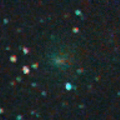
|
It brightened up to 14.2 mag in August (Aug. 18, Alan Hale). It approached to Sun down to 0.47 a.u. in September, and it was expected to brighten up to 11 mag. But actually, it was fainter than predicted. It is not observable after this.
Date(TT) R.A. (2000) Decl. Delta r Elong. m1 Best Time(A, h)
Sept.19 10 15.15 -1 57.5 1.213 0.487 23 11.3 4:21 (271, -1)
Sept.26 10 53.35 -3 39.6 1.382 0.552 19 12.1 4:26 (272, -3)
|

|
Now it is 11.2 mag (Sept. 11, Carlos Labordena). It will be unobservable in early October.
Date(TT) R.A. (2000) Decl. Delta r Elong. m1 Best Time(A, h)
Sept.19 14 37.65 -3 29.6 3.036 2.403 43 11.5 19:25 ( 75, 14)
Sept.26 14 47.26 -5 50.8 3.161 2.466 39 11.6 19:15 ( 75, 11)
|

|
Now it is 13.9 mag (Sept. 14, Michael Mattiazzo). Although it is a tiny comet, it will approach to Sun down to 0.34 a.u. on Oct. 20, and it is expected to brighten up to 8.5 mag. In the Southern Hemisphere, it stays observable in good condition until late September when it brightens up to 11.5 mag. In the Northern Hemisphere, it stays unobservable for a while. But it will appear in the morning sky at 10 mag in late October. Then it stasy observable while the comet will be fading rapidly.
Date(TT) R.A. (2000) Decl. Delta r Elong. m1 Best Time(A, h)
Sept.19 12 30.13 -52 17.8 0.888 0.874 54 13.2 19:25 ( 46,-34)
Sept.26 12 31.45 -47 2.3 0.810 0.730 46 12.2 19:15 ( 54,-35)
|

|
Now it is 13 mag (Sept. 11, Giuseppe Pappa). It is very bright as 11.3 mag visually (Sept. 12, Carlos Labordena). It approaches to Earth down to 0.7 a.u. in September, and it will brighten up to 13 mag. It stays observable in excellent condition in the Northern Hemipshere. In the Southern Hemipshere, it is not obserbvable until early October.
Date(TT) R.A. (2000) Decl. Delta r Elong. m1 Best Time(A, h)
Sept.19 2 43.58 65 54.1 0.764 1.416 105 12.9 2:58 (180, 59)
Sept.26 23 27.68 67 25.3 0.731 1.456 113 13.0 22:49 (180, 58)
|

|
It brightened up to 13.5 mag in summer (July 31, Ken-ichi Kadota). Now it is not observable. It is expected to brighten up to 12 mag from autumn to winter. In the Southern Hemisphere, it will appear in the morning sky in December, then it stays observable in good condition. In the Northern Hemisphere, it will be observable in the extremely low sky only from November to December.
Date(TT) R.A. (2000) Decl. Delta r Elong. m1 Best Time(A, h)
Sept.19 12 47.56 15 30.6 2.865 1.957 20 13.3 19:25 (107, 2)
Sept.26 12 53.81 12 9.4 2.850 1.914 17 13.2 19:15 (106, -2)
|

|
Outburst occured on July 27. It is bright as 12.8 mag still now (Aug. 30, Ken Harikae).
Date(TT) R.A. (2000) Decl. Delta r Elong. m1 Best Time(A, h)
Sept.19 2 51.64 27 30.0 5.167 5.825 126 13.3 3:00 ( 0, 83)
Sept.26 2 49.95 27 33.8 5.087 5.826 133 13.3 2:31 ( 0, 83)
|
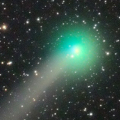
|
It brightened up to 6.0 mag in June (June 13, Marco Goiato). Now it is fading. It has already faded down to 11.8 mag (Sept. 11, Carlos Labordena). It stays observable in good condition for a long time after this.
Date(TT) R.A. (2000) Decl. Delta r Elong. m1 Best Time(A, h)
Sept.19 15 57.06 22 57.6 1.967 1.781 64 14.1 19:25 ( 89, 45)
Sept.26 16 13.76 23 0.8 2.084 1.869 63 14.6 19:15 ( 89, 45)
|
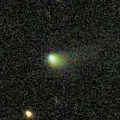
|
Now it is 14.2 mag (July 16, Paul Camilleri). It stays 13-14 mag from 2020 to 2021. It will be unobservable soon.
Date(TT) R.A. (2000) Decl. Delta r Elong. m1 Best Time(A, h)
Sept.19 14 2.81 -4 4.6 3.758 2.985 34 14.4 19:25 ( 80, 6)
Sept.26 14 12.40 -5 19.7 3.795 2.975 30 14.4 19:15 ( 80, 4)
|
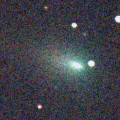
|
Recovered from SWAN images after 24-year blank. It brightened up to 10.2 mag in spring (May 31, Marco Goiato). Now it is fading very rapidly. It has already faded down to 15.2 mag (Aug. 21, Sandor Szabo). It stays observable for a long time after this until the comet fades out.
Date(TT) R.A. (2000) Decl. Delta r Elong. m1 Best Time(A, h)
Sept.19 6 50.16 9 52.7 1.907 1.894 73 14.6 4:21 (295, 46)
Sept.26 7 0.12 9 9.9 1.884 1.945 78 14.9 4:26 (302, 50)
|

|
Now it is 14.2 mag (Sept. 7, Thomas Lehmann). It stays 14 mag until autumn. In the Southern Hemisphere, it will never be observable again.
Date(TT) R.A. (2000) Decl. Delta r Elong. m1 Best Time(A, h)
Sept.19 14 7.78 71 15.3 4.476 4.298 73 14.7 19:25 (157, 37)
Sept.26 14 20.90 69 34.4 4.508 4.341 74 14.8 19:15 (155, 36)
|
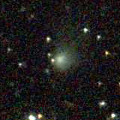
|
Now it is 15.3 mag (Sept. 5, Thomas Lehmann). It is expected to be observable at 5-6 mag for a long time from 2022 to 2023. In the Northern Hemisphere, it is not observable at the high light from 2022 summer to 2023 summer. In the Southern Hemisphere, it is only visible in the extremely low sky in summer in 2020. But it will be observable in good condition at the high light.
Date(TT) R.A. (2000) Decl. Delta r Elong. m1 Best Time(A, h)
Sept.19 17 4.73 44 16.2 8.320 8.232 81 14.8 19:25 (120, 63)
Sept.26 17 5.70 43 19.7 8.312 8.180 79 14.7 19:15 (117, 60)
|
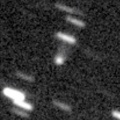
|
Now it is 15.9 mag (Aug. 14, ATLAS-MLO, Mauna Loa). It will brighten up to 13 mag in 2021. In the Southern Hemisphere, it stays observable at 15 mag until October. In the Northern Hemisphere, it is not observable until July in 2022.
Date(TT) R.A. (2000) Decl. Delta r Elong. m1 Best Time(A, h)
Sept.19 14 16.36 -29 43.7 4.978 4.363 47 14.9 19:25 ( 58, -6)
Sept.26 14 21.97 -30 37.5 5.012 4.329 42 14.9 19:15 ( 58, -9)
|
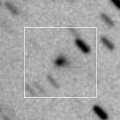
|
Now it is 15 mag (Sept. 11, Giuseppe Pappa). It will brighten up to 12 mag in winter in 2022. In the Northern Hemisphere, it stays observable in good condition for a long time. In the Southern Hemisphere, it is not observable until 2021 November.
Date(TT) R.A. (2000) Decl. Delta r Elong. m1 Best Time(A, h)
Sept.19 0 39.51 65 26.8 5.014 5.476 112 15.1 0:48 (180, 59)
Sept.26 0 33.55 65 43.8 4.927 5.432 115 15.0 0:15 (180, 59)
|
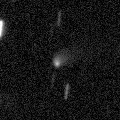
|
Now it is 15.0 mag (Aug. 28, Chris Wyatt). It stays 14-15 mag until 2021. In the Southern Hemisphere, it stays observable in good condition for a long time. In the Northern Hemisphere, it is not observable until June in 2021.
Date(TT) R.A. (2000) Decl. Delta r Elong. m1 Best Time(A, h)
Sept.19 16 45.11 -73 37.9 4.529 4.590 87 15.2 19:25 ( 11,-22)
Sept.26 17 3.05 -72 39.6 4.570 4.572 83 15.2 19:15 ( 11,-21)
|

|
It was expected to brighten very rapidly, and brighten up to 14.5 mag from August to September. However, its current brightness is very uncertain. It could not be detected as fainter than 18.0 mag on June 30 (Charles S. Morris), and fainter than 15.7 mag on July 13 (Sandor Szabo). However, Giuseppe Pappa reported as 14 mag on July 10, and Thomas Lehmann reported it is bright as 15.2 mag on July 12. In the Northern Hemisphere, it stays observable for a long time, although it becomes extremely low in early September. In the Southern Hemisphere, it is not observable until late October.
Date(TT) R.A. (2000) Decl. Delta r Elong. m1 Best Time(A, h)
Sept.19 10 47.02 27 22.5 1.751 1.007 29 15.2 4:21 (243, 9)
Sept.26 10 48.37 22 43.6 1.776 1.057 31 15.5 4:26 (251, 12)
|

|
Now it is 14.5 mag (Aug. 18, T. Prystavski). It will brighten up to 13.5 mag in spring in 2021. In the Southern Hemisphere, it stays observable in good condition for a long time. In the Northern Hemisphere, it is not observable until spring in 2021.
Date(TT) R.A. (2000) Decl. Delta r Elong. m1 Best Time(A, h)
Sept.19 17 25.94 -56 51.8 3.781 3.886 88 15.3 19:25 ( 15, -5)
Sept.26 17 20.24 -55 13.3 3.869 3.855 81 15.3 19:15 ( 19, -5)
|

|
Now it is 15.5 mag (Aug. 18, Giuseppe Pappa). It stays 15.5 mag from summer to winter, and observable in good condition. It locates somewhat low in the Southern Hemisphere.
Date(TT) R.A. (2000) Decl. Delta r Elong. m1 Best Time(A, h)
Sept.19 7 24.50 18 56.5 2.158 1.981 66 15.4 4:21 (278, 45)
Sept.26 7 37.34 18 41.0 2.118 2.012 70 15.4 4:26 (282, 49)
|
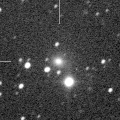
|
It brightened up to 13.5 mag in winter (Dec. 6, Chris Wyatt). Now it is fading slowly. Now it is 14.9 mag (Aug. 28, Chris Wyatt). In the Southern Hemisphere, it stays observable for a long time. It locates somewhat low in the Northern Hemisphere. Taras Prystavski found its fragmentation on Sept. 12.
Date(TT) R.A. (2000) Decl. Delta r Elong. m1 Best Time(A, h)
Sept.19 2 54.33 -37 55.8 3.694 4.332 123 15.7 3:02 ( 0, 17)
Sept.26 2 45.82 -38 5.1 3.692 4.369 126 15.7 2:27 ( 0, 17)
|

|
Now it is 15.7 mag (Sept. 5, Thomas Lehmann). It stays 15-16 mag for a long time until 2021.
Date(TT) R.A. (2000) Decl. Delta r Elong. m1 Best Time(A, h)
Sept.19 18 31.76 19 46.2 4.253 4.540 100 15.7 19:25 ( 38, 71)
Sept.26 18 28.77 19 34.0 4.360 4.550 94 15.8 19:15 ( 49, 68)
|
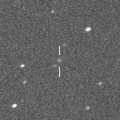
|
Now it is 15.7 mag (Sept. 11, Giuseppe Pappa). It will brighten up to 14.5 mag from spring to summer in 2021. In the Southern Hemisphere, it stays observable in excellent condition for a long time. In the Northern Hemisphere, it is observable in good condition in 2020, however, it will be unobservable in 2021.
Date(TT) R.A. (2000) Decl. Delta r Elong. m1 Best Time(A, h)
Sept.19 21 59.07 -14 25.4 2.542 3.452 150 15.9 22:03 ( 0, 40)
Sept.26 21 49.55 -16 58.0 2.574 3.408 140 15.9 21:26 ( 0, 38)
|

|
Now it is 15.3 mag (Aug. 28, Chris Wyatt). It brightens up to 16 mag from summer to winter. In the Southern Hemisphere, it is observable in excellent condition. In the Northern Hemisphere, it is not observable until late October.
Date(TT) R.A. (2000) Decl. Delta r Elong. m1 Best Time(A, h)
Sept.19 20 44.81 -64 13.5 0.919 1.569 109 16.0 20:51 ( 0, -9)
Sept.26 20 44.84 -61 11.6 0.905 1.528 106 16.0 20:23 ( 0, -6)
|
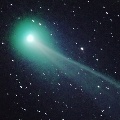
|
It brightened up to 4.7 mag in early May (May 2, Marco Goiato). However, it has faded and got diffused after that. It had already faded down to 7.3 mag in late May (May 21, Mitsunori Tsumura). It is appearing in the morning sky. However, maybe it has already disappeared. It stays observable in good condition after this.
Date(TT) R.A. (2000) Decl. Delta r Elong. m1 Best Time(A, h)
Sept.19 6 42.25 8 3.5 2.264 2.242 75 16.0 4:21 (299, 46)
Sept.26 6 38.18 6 2.2 2.236 2.344 83 16.1 4:26 (312, 51)
|

|
Now it is 16.5 mag (Sept. 7, Thomas Lehmann). It will stay at 15 mag for a long time from 2021 to 2022. In the Northern Hemisphere, it stays observable in good condition while brightening gradually. In the Southern Hemisphere, it stays locating low for a long time.
Date(TT) R.A. (2000) Decl. Delta r Elong. m1 Best Time(A, h)
Sept.19 17 28.16 19 19.4 5.880 5.883 85 16.0 19:25 ( 65, 61)
Sept.26 17 27.74 17 57.5 5.945 5.856 80 16.0 19:15 ( 68, 57)
|

|
Now it is 16.2 mag (Aug. 15, Toshihiko Ikemura, Hirohisa Sato). It is observable at 15-16 mag in 2020. It is observable in excellent condition in the Southern Hemisphere. It locates somewhat low in the Northern Hemisphere.
Date(TT) R.A. (2000) Decl. Delta r Elong. m1 Best Time(A, h)
Sept.19 18 2.64 -25 33.5 6.744 6.893 94 16.1 19:25 ( 20, 27)
Sept.26 18 0.92 -25 12.2 6.888 6.911 87 16.2 19:15 ( 24, 26)
|

|
Now it is 15.8 mag (Sept. 5, Thomas Lehmann). It stays observable until December when it becomes fainter than 18 mag.
Date(TT) R.A. (2000) Decl. Delta r Elong. m1 Best Time(A, h)
Sept.19 19 31.98 -11 13.1 1.457 2.104 116 16.2 19:38 ( 0, 44)
Sept.26 19 40.24 -11 58.8 1.534 2.117 111 16.3 19:19 ( 0, 43)
|
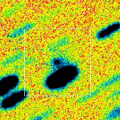
|
Now it is 17.2 mag (Aug. 17, P. Camilleri, H. Williams). It brightens up to 15 mag in winter. But it is not observable at high light. In the Southern Hemisphere, it stays observable in good condition until autumn when the comet will brighten up to 16 mag. It stays locating very low in the Northern Hemisphere.
Date(TT) R.A. (2000) Decl. Delta r Elong. m1 Best Time(A, h)
Sept.19 18 11.54 -34 27.1 2.059 2.384 96 16.3 19:25 ( 15, 19)
Sept.26 18 19.55 -33 18.1 2.119 2.360 91 16.2 19:15 ( 17, 19)
|

|
Now it is 15.6 mag (Aug. 24, Katsumi Yoshimoto). It stays 16 mag until late September. It is observable in good condition in the Northern Hemisphere. It locates low in the Southern Hemisphere.
Date(TT) R.A. (2000) Decl. Delta r Elong. m1 Best Time(A, h)
Sept.19 7 25.61 22 18.1 1.366 1.334 66 16.3 4:21 (274, 46)
Sept.26 7 46.58 21 45.4 1.362 1.363 68 16.4 4:26 (276, 49)
|

|
Now it is 16.7 mag (Aug. 30, ATLAS-MLO, Mauna Loa). It is expected to brighten up to 16 mag from October to November, and it will be observable in excellent condition.
Date(TT) R.A. (2000) Decl. Delta r Elong. m1 Best Time(A, h)
Sept.19 0 0.72 -36 58.4 0.564 1.500 144 16.4 0:10 ( 0, 18)
Sept.26 23 53.05 -35 25.5 0.535 1.466 143 16.3 23:30 ( 0, 20)
|

|
It passed the perihelion on June 25, and brightened up to 7.3 mag (June 30, Chris Wyatt). Now it is fading. It has already faded down to 14.3 mag (Aug. 20, Ken-ichi Kadota). In the Southern Hemisphere, it stays observable in good condition in the evening sky while the comet will be fading. It locates very low in the Northern Hemisphere.
Date(TT) R.A. (2000) Decl. Delta r Elong. m1 Best Time(A, h)
Sept.19 17 13.16 -31 15.0 1.386 1.620 83 16.3 19:25 ( 28, 18)
Sept.26 17 34.46 -30 45.0 1.539 1.708 81 16.9 19:15 ( 27, 18)
|
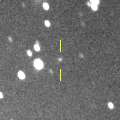
|
Now it is 15.9 mag (Apr. 24, J. Drummond). It is expected to brighten up to 13 mag in 2022. In 2020, it is observable in excellent condition in the Southern Hemisphere. In the Northern Hemisphere, it is observable from autumn to winter, but it locating extremely low.
Date(TT) R.A. (2000) Decl. Delta r Elong. m1 Best Time(A, h)
Sept.19 8 7.11 -29 37.9 6.987 6.556 60 16.4 4:21 (312, 5)
Sept.26 8 11.53 -30 20.5 6.898 6.516 63 16.3 4:26 (317, 9)
|
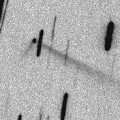
|
Now it is 17.5 mag (Aug. 15, Toshihiko Ikemura, Hirohisa Sato). Main-belt asteroid. But it showed a straight tail like a comet in 2019. In 2020, it brightens up to 16.5 mag and stays observable in good condition from September to October.
Date(TT) R.A. (2000) Decl. Delta r Elong. m1 Best Time(A, h)
Sept.19 0 25.50 3 41.1 1.267 2.261 168 16.7 0:34 ( 0, 59)
Sept.26 0 19.83 1 34.2 1.275 2.277 177 16.5 0:01 ( 0, 57)
|
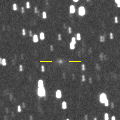
|
Now it is 16.4 mag (Aug. 20, Thomas Lehmann). It stays 16.5 mag until October, and observable in good condition.
Date(TT) R.A. (2000) Decl. Delta r Elong. m1 Best Time(A, h)
Sept.19 20 17.51 8 31.0 1.383 2.143 127 16.5 20:23 ( 0, 63)
Sept.26 20 22.10 6 57.1 1.432 2.146 122 16.6 20:00 ( 0, 62)
|
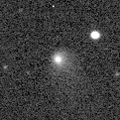
|
It brightened up to 13.8 mag in autumn in 2019 (Sept. 3, Chris Wyatt). Now it is fading slowly. Now it is 15.5 mag (Sept. 11, Giuseppe Pappa). In 2020, it stays observable in good condition while the comet will be fading from 16 to 17 mag.
Date(TT) R.A. (2000) Decl. Delta r Elong. m1 Best Time(A, h)
Sept.19 0 12.51 1 44.0 5.286 6.284 172 16.6 0:21 ( 0, 57)
Sept.26 0 8.24 1 46.9 5.323 6.325 179 16.6 23:45 ( 0, 57)
|
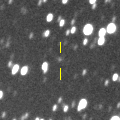
|
Now it is 16.5 mag (Sept. 11, Giuseppe Pappa). It is observable at 16.5-17 mag from 2020 to 2021. In the Southern Hemisphere, it is not observable until summer in 2021.
Date(TT) R.A. (2000) Decl. Delta r Elong. m1 Best Time(A, h)
Sept.19 23 35.18 73 44.7 5.724 6.058 104 16.6 23:38 (180, 51)
Sept.26 23 15.33 72 51.0 5.666 6.049 107 16.6 22:51 (180, 52)
|

|
New comet discovered in the images of SOHO spacecraft. It approached to Sun down to 0.09 a.u. on Aug. 8, and it brightened up to 3 mag. It will appear in the morning sky in October. But it must be fainter than 18 mag.
Date(TT) R.A. (2000) Decl. Delta r Elong. m1 Best Time(A, h)
Sept.19 10 28.55 0 39.2 2.146 1.244 19 16.6 4:21 (267, -3)
Sept.26 10 38.92 -0 31.9 2.254 1.389 23 17.2 4:26 (272, 1)
|
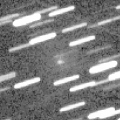
|
Now it is 15.0-15.5 mag (Sept. 19, Michael Jager). It will approach to Sun down to 0.4 a.u. on Dec. 13, and it is expected to brighten up to 9.5 mag. It stays observable while the comet is brightening until late November when it brightens up to 10 mag.
Date(TT) R.A. (2000) Decl. Delta r Elong. m1 Best Time(A, h)
Sept.19 7 45.64 8 48.2 2.083 1.809 60 17.2 4:21 (285, 35)
Sept.26 8 4.10 7 11.4 1.913 1.697 62 16.7 4:26 (290, 37)
|
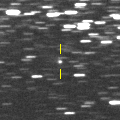
|
Now it is 16.0 mag (Aug. 20, Sandor Szabo). It is observable at 16.5-17 mag from spring in 2020 to summer in 2021.
Date(TT) R.A. (2000) Decl. Delta r Elong. m1 Best Time(A, h)
Sept.19 17 18.62 6 10.5 4.661 4.647 82 16.8 19:25 ( 51, 50)
Sept.26 17 17.04 4 46.4 4.772 4.643 76 16.9 19:15 ( 55, 46)
|
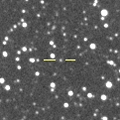
|
Now it is 16.9 mag (Aug. 26, Charles S. Morris). It stays at 17 mag from 2020 to 2021.
Date(TT) R.A. (2000) Decl. Delta r Elong. m1 Best Time(A, h)
Sept.19 18 58.16 31 15.3 8.569 8.874 104 17.1 19:25 ( 53, 84)
Sept.26 18 56.82 30 58.7 8.634 8.870 100 17.1 19:15 ( 67, 81)
|

|
First return of a new periodic comet which brightened up to 17.5 mag in 2012. Now it is 17.5 mag (Aug. 15, Toshihiko Ikemura, Hirohisa Sato). It stays observable at 17 mag in good condition from summer to winter. It locates somewhat low in the Southern Hemisphere.
Date(TT) R.A. (2000) Decl. Delta r Elong. m1 Best Time(A, h)
Sept.19 5 1.34 31 54.0 2.001 2.371 98 17.1 4:21 (283, 79)
Sept.26 5 7.94 32 45.9 1.935 2.385 103 17.1 4:26 (295, 85)
|

|
It brightened up to 13.2 mag from spring to autumn in 2019 (June 30, Thomas Lehmann). Now it is fading slowly. It has already faded down to 16.2 mag (Sept. 11, Giuseppe Pappa). In the Southern Hemisphere, it stays observable for a long time. In the Northern Hemisphere, it stays low for a long time.
Date(TT) R.A. (2000) Decl. Delta r Elong. m1 Best Time(A, h)
Sept.19 22 44.88 -29 44.0 3.824 4.708 148 17.2 22:49 ( 0, 25)
Sept.26 22 37.49 -29 8.6 3.916 4.748 142 17.3 22:14 ( 0, 26)
|

|
First return of a new periodic comet which brightened up to 13 mag in 2009. Now it is 18.0 mag (Aug. 18, Mt. Lemmon Survey). It is expected to brighten up to 12 mag and to be observable in excellent condition in winter.
Date(TT) R.A. (2000) Decl. Delta r Elong. m1 Best Time(A, h)
Sept.19 3 21.17 -2 23.7 0.897 1.697 126 17.8 3:29 ( 0, 53)
Sept.26 3 31.20 -3 33.2 0.820 1.653 129 17.3 3:11 ( 0, 52)
|

|
Now it is 20.3 mag (Aug. 21, J. Nicolas, F. Kugel). It is expected to brighten up to 16 mag from autumn to winter. It is observable in excellent condition in the Northern Hemisphere. It locates somewhat low in the Southern Hemisphere.
Date(TT) R.A. (2000) Decl. Delta r Elong. m1 Best Time(A, h)
Sept.19 2 29.65 41 0.3 1.372 2.102 123 17.6 2:38 (180, 84)
Sept.26 2 32.27 41 55.5 1.300 2.078 128 17.4 2:13 (180, 83)
|

|
Now it is 16.9 mag (Aug. 24, P. Camilleri, H. Williams). It will brighten up to 15.5 mag in early 2021. In 2020, it stays observable at 17 mag until November in the Southern Hemisphere. In the Northern Hemisphere, it stays unobservable until 2021 June.
Date(TT) R.A. (2000) Decl. Delta r Elong. m1 Best Time(A, h)
Sept.19 15 4.20 -30 5.4 2.922 2.515 56 17.5 19:25 ( 51, 1)
Sept.26 15 16.00 -30 29.7 2.937 2.460 52 17.5 19:15 ( 51, 0)
|

|
It brightened up to 7.7 mag in June in 2018 (June 19, Juan Jose Gonzalez). Now it is fading. It has already faded down to 16.9 mag (Apr. 22, J. Drummond). In the Southern Hemisphere, it stays observable for a long time until the comet will fade out. It will be observable in good condition after this also in the Northern Hemisphere.
Date(TT) R.A. (2000) Decl. Delta r Elong. m1 Best Time(A, h)
Sept.19 6 39.73 -11 20.3 7.801 7.641 77 17.5 4:21 (316, 32)
Sept.26 6 40.04 -11 36.0 7.755 7.693 82 17.5 4:26 (325, 36)
|

|
Now it is 17.3 mag (Aug. 16, W. Hasubick). It stays 17.5 mag until November. It is observable in excellent condition in the Southern Hemisphere. It locates very low in the Northern Hemisphere.
Date(TT) R.A. (2000) Decl. Delta r Elong. m1 Best Time(A, h)
Sept.19 23 12.89 -34 36.0 2.254 3.138 145 17.5 23:17 ( 0, 20)
Sept.26 23 9.26 -35 23.0 2.297 3.137 140 17.5 22:46 ( 0, 20)
|
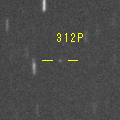
|
Now it is 18.5 mag (Aug. 27, ATLAS-MLO, Mauna Loa). It will brighten up to 17.5 mag in September. It is observable in excellent condition in the Southern Hemisphere. It locates somewhat low in the Northern Hemisphere.
Date(TT) R.A. (2000) Decl. Delta r Elong. m1 Best Time(A, h)
Sept.19 23 13.34 -22 36.5 1.018 1.984 157 17.5 23:18 ( 0, 32)
Sept.26 23 11.85 -24 11.5 1.047 1.983 150 17.6 22:49 ( 0, 31)
|

|
Now it is 18.6 mag (Aug. 6, Palomar Mountain--ZTF). It will approach to Sun down to 0.14 a.u. on Dec. 7, and will brighten up to 11 mag. But it is not observable at the high light. It is observable until November when it brightens up to 16 mag.
Date(TT) R.A. (2000) Decl. Delta r Elong. m1 Best Time(A, h)
Sept.19 7 18.83 28 16.0 1.592 1.548 68 17.8 4:21 (266, 50)
Sept.26 7 38.34 27 18.9 1.442 1.470 71 17.5 4:26 (270, 53)
|
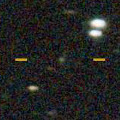
|
Now it is 17.3 mag (Aug. 22, ATLAS-MLO, Mauna Loa). It became brighter than orignally predicted. It will be fading after this, and will be fainter than 18 mag in October. It locates extremely low in the Northern Hemisphere.
Date(TT) R.A. (2000) Decl. Delta r Elong. m1 Best Time(A, h)
Sept.19 15 14.46 -23 7.5 2.471 2.088 56 17.6 19:25 ( 54, 8)
Sept.26 15 30.25 -24 5.1 2.530 2.090 53 17.6 19:15 ( 54, 7)
|
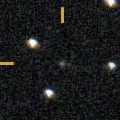
|
Now it is 18.6 mag (Aug. 24, ATLAS-MLO, Mauna Loa). It is observable at 17-18 mag for a long time from late 2019 to early 2021. It will fade out before it passes the perihelion.
Date(TT) R.A. (2000) Decl. Delta r Elong. m1 Best Time(A, h)
Sept.19 5 54.59 16 21.9 4.550 4.618 87 17.6 4:21 (303, 61)
Sept.26 5 57.53 16 24.1 4.433 4.606 93 17.6 4:26 (315, 65)
|
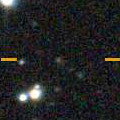
|
Now it is 19.3 mag (Aug. 19, P. Carson). It will brighten up to 13.5 mag from winter to spring in 2021. In the Northern Hemisphere, it stays observable in excellent condition. In the Southern Hemisphere, it stays extremely low until 2021 spring.
Date(TT) R.A. (2000) Decl. Delta r Elong. m1 Best Time(A, h)
Sept.19 0 20.74 49 45.0 1.987 2.725 128 17.8 0:30 (180, 75)
Sept.26 0 13.26 50 24.6 1.885 2.651 130 17.6 23:50 (180, 74)
|
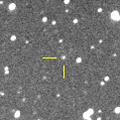
|
Now it is 17.7 mag (Aug. 15, Toshihiko Ikemura, Hirohisa Sato). It was observed at 17 mag in 2019. In 2020, it is observable at 17.5 mag in good condition from summer to autumn.
Date(TT) R.A. (2000) Decl. Delta r Elong. m1 Best Time(A, h)
Sept.19 0 49.63 -6 52.0 2.798 3.771 163 17.6 0:58 ( 0, 48)
Sept.26 0 45.33 -7 12.4 2.792 3.778 168 17.7 0:26 ( 0, 48)
|
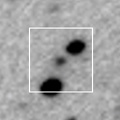
|
Now it is 18.8 mag (Aug. 30, P. Carson). It will approach to Earth down to 0.5 a.u. in November, and brighten up to 17 mag. It is observable in excellent condition.
Date(TT) R.A. (2000) Decl. Delta r Elong. m1 Best Time(A, h)
Sept.19 23 31.91 32 9.9 0.637 1.575 146 18.0 23:36 ( 0, 87)
Sept.26 23 30.81 31 54.8 0.597 1.541 147 17.8 23:08 ( 0, 87)
|

|
It stays observable at 17 mag for a long time until 2027. In the Southern Hemipshere, it stays observable in good condition for a long time. It is not observable in the Northern Hemipsphere.
Date(TT) R.A. (2000) Decl. Delta r Elong. m1 Best Time(A, h)
Sept.19 9 58.28 -45 26.0 12.560 11.977 52 17.8 4:21 (311,-22)
Sept.26 10 0.29 -45 57.4 12.533 11.959 53 17.8 4:26 (315,-17)
|

|
Now it is 18.0 mag (Aug. 5, L. S. Amaral). It will brighten up to 16.5 mag in 2021 summer. In the Southern Hemisphere, it stays observable for a while. In the Northern Hemisphere, it is not observable until 2021 February.
Date(TT) R.A. (2000) Decl. Delta r Elong. m1 Best Time(A, h)
Sept.19 14 59.68 -45 9.3 5.931 5.552 63 17.8 19:25 ( 40, -9)
Sept.26 15 6.24 -44 27.3 5.994 5.528 57 17.8 19:15 ( 42,-10)
|
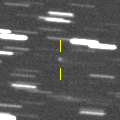
|
Now it is 17.7 mag (Aug. 24, ATLAS-MLO, Mauna Loa). It stays observable at 17.5-18 mag in good condition until winter.
Date(TT) R.A. (2000) Decl. Delta r Elong. m1 Best Time(A, h)
Sept.19 6 42.56 16 58.5 1.944 1.962 76 17.9 4:21 (289, 52)
Sept.26 6 55.19 17 0.4 1.892 1.979 79 17.8 4:26 (294, 56)
|
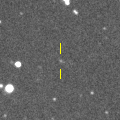
|
Now it is 17.3 mag (Aug. 13, Toshihiko Ikemura, Hirohisa Sato). It stays 18 mag from 2019 to 2020.
Date(TT) R.A. (2000) Decl. Delta r Elong. m1 Best Time(A, h)
Sept.19 20 48.89 -8 42.3 3.834 4.603 135 17.9 20:54 ( 0, 46)
Sept.26 20 48.04 -9 5.6 3.915 4.605 128 17.9 20:26 ( 0, 46)
|
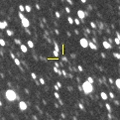
|
Sam Deen pointed out that it brightened in outburst twice in 2017 and 2019. It was observed at 20-21 mag in 2017. Then it became fainter than 22.9 mag in 2018 summer (Aug. 29, Sam Deen). However, it brightened up to 17.2 mag in 2019 spring (Mar. 25, B. T. Bolin). Then it faded again down to 19.9 mag (May 29, Toshihiko Ikemura, Hirohisa Sato). Now it is 18.1 mag (July 9, J. Jahn). It is predicted to stay observable at 18 mag for a long time from 2019 to 2021. But actually, it may be fainter than this ephemeris.
Date(TT) R.A. (2000) Decl. Delta r Elong. m1 Best Time(A, h)
Sept.19 18 24.57 -26 52.7 7.534 7.759 99 17.9 19:25 ( 14, 27)
Sept.26 18 24.59 -27 16.5 7.659 7.765 92 18.0 19:15 ( 18, 25)
|
|
![]()
 C/2020 Q1 ( Borisov )
C/2020 Q1 ( Borisov ) C/2019 N1 ( ATLAS )
C/2019 N1 ( ATLAS ) 29P/Schwassmann-Wachmann 1
29P/Schwassmann-Wachmann 1 C/2019 U6 ( Lemmon )
C/2019 U6 ( Lemmon ) 246P/NEAT
246P/NEAT 58P/Jackson-Neujmin
58P/Jackson-Neujmin C/2018 N2 ( ASASSN )
C/2018 N2 ( ASASSN ) C/2017 K2 ( PanSTARRS )
C/2017 K2 ( PanSTARRS ) C/2019 F1 ( ATLAS-Africano )
C/2019 F1 ( ATLAS-Africano ) C/2019 L3 ( ATLAS )
C/2019 L3 ( ATLAS ) C/2020 F5 ( MASTER )
C/2020 F5 ( MASTER ) C/2020 H4 ( Leonard )
C/2020 H4 ( Leonard ) C/2020 J1 ( SONEAR )
C/2020 J1 ( SONEAR ) 84P/Giclas
84P/Giclas C/2018 F4 ( PanSTARRS )
C/2018 F4 ( PanSTARRS ) C/2019 K7 ( Smith )
C/2019 K7 ( Smith ) C/2019 T2 ( Lemmon )
C/2019 T2 ( Lemmon ) 162P/Siding Spring
162P/Siding Spring C/2020 F8 ( SWAN )
C/2020 F8 ( SWAN ) C/2018 U1 ( Lemmon )
C/2018 U1 ( Lemmon ) C/2017 U7 ( PanSTARRS )
C/2017 U7 ( PanSTARRS ) 115P/Maury
115P/Maury 17P/Holmes
17P/Holmes 304P/Ory
304P/Ory 156P/Russell-LINEAR
156P/Russell-LINEAR 2P/Encke
2P/Encke C/2019 T4 ( ATLAS )
C/2019 T4 ( ATLAS ) (6478) Gault
(6478) Gault 257P/Catalina
257P/Catalina C/2017 B3 ( LINEAR )
C/2017 B3 ( LINEAR ) C/2019 T3 ( ATLAS )
C/2019 T3 ( ATLAS ) C/2020 P4 ( SOHO )
C/2020 P4 ( SOHO ) C/2020 S3 ( Erasmus )
C/2020 S3 ( Erasmus ) C/2017 Y2 ( PanSTARRS )
C/2017 Y2 ( PanSTARRS ) C/2019 O3 ( Palomar )
C/2019 O3 ( Palomar ) P/2020 M2 ( Lemmon )
P/2020 M2 ( Lemmon ) C/2018 A6 ( Gibbs )
C/2018 A6 ( Gibbs ) P/2020 P2 ( Boattini )
P/2020 P2 ( Boattini ) 277P/LINEAR
277P/LINEAR 28P/Neujmin 1
28P/Neujmin 1 C/2016 M1 ( PanSTARRS )
C/2016 M1 ( PanSTARRS ) 254P/McNaught
254P/McNaught 312P/NEAT
312P/NEAT (3200) Phaethon
(3200) Phaethon 278P/McNaught
278P/McNaught 173P/Mueller 5
173P/Mueller 5 C/2020 N1 ( PanSTARRS )
C/2020 N1 ( PanSTARRS ) 215P/NEAT
215P/NEAT 11P/Tempel-Swift-LINEAR
11P/Tempel-Swift-LINEAR C/2019 E3 ( ATLAS )
C/2019 E3 ( ATLAS ) C/2020 O2 ( Amaral )
C/2020 O2 ( Amaral ) 178P/Hug-Bell
178P/Hug-Bell P/2019 LD2 ( ATLAS )
P/2019 LD2 ( ATLAS ) C/2017 K5 ( PanSTARRS )
C/2017 K5 ( PanSTARRS )![]()













































